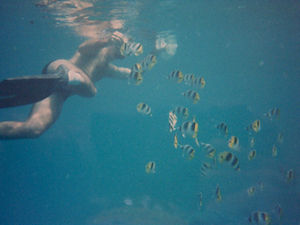You are here :
Home
>
Pictures and tips for a good travel
>
Apnea - snorkeling
>
Use of tuba
Introduction
to diving for people a little bit afraid of water
* How to use the tuba
 The first thing the beginners should know is that the water enters often inside the tuba, so you've to get used to it. Before each inspiration, you've to strongly blow into the tuba to empty the pipe, and when you do it, always check that the extremity of the tuba is outside the water. The blow has to be pretty strong to be sure all the water goes out. Otherwise it's useless. Don't worry: i'll explain you everything steps by steps.
The first thing the beginners should know is that the water enters often inside the tuba, so you've to get used to it. Before each inspiration, you've to strongly blow into the tuba to empty the pipe, and when you do it, always check that the extremity of the tuba is outside the water. The blow has to be pretty strong to be sure all the water goes out. Otherwise it's useless. Don't worry: i'll explain you everything steps by steps.
If you're already inside the water and you feel ready to try the tuba,
put it under the elastic which hold your mask and then put it in your mouth. Place the extremity of the tuba backwords, as much as you can. Otherwise, when you'll lean forward, the extremity of the tuba will fall into the water and so it'll be unusable.
Repeat this operation leaning forward to immerse the masque into the water: If the tube is not under the water, you can calmly breath while you're observing the sea bottoms. You've to know that water can enter inside the tuba at any moment, so don't panic if this happens. (Turn your head up and take the tuba out of your mouth. Then, starts to breath easy again.). When you feel safe and after you've repeated this gesture several times, try to lean a bit more and enjoy the sight. Breath normally (always keep enough air inside the lungs). When you'll have more experience, you'll take your breath each 20 seconds:in this way you'll make less noise and so the fishes won't get scared and they'll show themselves more easily.
As you know, that water can enters inside the tuba at any moment, so the best way to overcome this fear is to do it voluntarily, at the beginning. Like this, the next time it happens, you'll know how to manage it. Breath easy, then lean more and more forward (don't forget that you never have to completely empty your lungs, becuase it's you emergency air reserve). Just when the water enters, start to inspire. Turn your head up and expire strongly. Once the tuba is empty agian, you can restart to breath normally.
Sometimes happens to use your emergency air reserve. In that case, you won't have enough air inside your lungs to empty the pipe. It's surely annoying, but don't worry: this is the worst ting that chan happens to you when you dive, so you don't really have to be scared. So don't panic and rise to the surface, take the tuba out of your mouth as quickly as possible and breath.
Now you've experienced the worst, you can continue with the lesson and enjoy the best of it. Squat down in the water after having repositioned the extremity of the tuba between the back and the crown of your head. Your head has to be slightly under the water surface.Then, let the water carry you and start to swim. A little reminder:
you'll float better when your lngs will be full of air. Another thing: use your air air reserve only when it's necessary (the air reserve is the quantity of air which stay in our lungs when we re-start to breath normally).


 The first thing the beginners should know is that the water enters often inside the tuba, so you've to get used to it. Before each inspiration, you've to strongly blow into the tuba to empty the pipe, and when you do it, always check that the extremity of the tuba is outside the water. The blow has to be pretty strong to be sure all the water goes out. Otherwise it's useless. Don't worry: i'll explain you everything steps by steps.
The first thing the beginners should know is that the water enters often inside the tuba, so you've to get used to it. Before each inspiration, you've to strongly blow into the tuba to empty the pipe, and when you do it, always check that the extremity of the tuba is outside the water. The blow has to be pretty strong to be sure all the water goes out. Otherwise it's useless. Don't worry: i'll explain you everything steps by steps. Use of tuba
Use of tuba 

